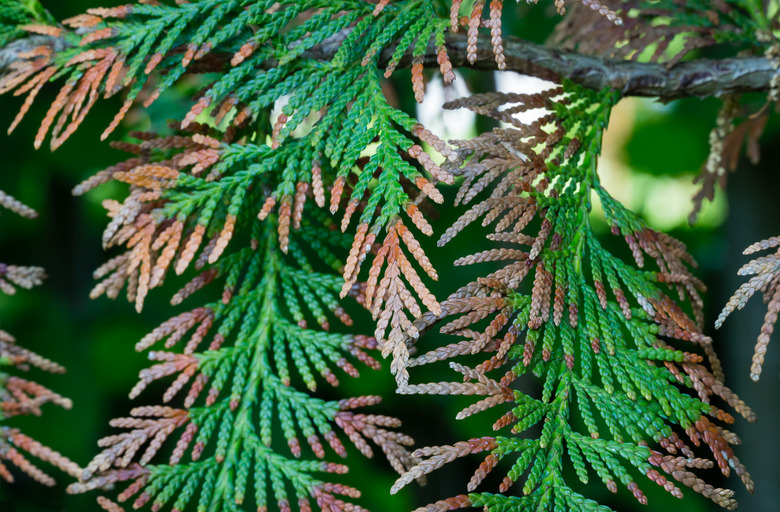How To Fix A Browning Evergreen Bush
We may receive a commission on purchases made from links.
A healthy evergreen bush has foliage that stays green year-round. Some leaf loss is normal for evergreens, especially in the late summer and fall. However, disease, weather conditions, or the wrong planting site can cause shrubs to turn brown. In some cases the plant will eventually die, but sometimes you can save a browning evergreen bush. Begin by determining the cause; then work to alleviate the problem and bring your evergreen bush back to health. With a little care and pruning, you can make your shrub attractive again.
Weather Conditions That Brown Evergreens
Weather Conditions That Brown Evergreens
Environmental conditions can dry out evergreens and turn leaves or needles brown. First, make sure your bush is properly sited in shade or sun, based on its requirements. Then consider whether the shrub is getting enough moisture. Evergreens with needles can be affected by winter burn on sunny days when roots are too frozen to draw water into the plant. The damage from winter burn is often seen on the south or southwest side of the plant. Harsh winter winds can also dry out leaves on unsheltered shrubs in winter. And finally, drought or very dry, hot summer weather is another factor.
If severe weather is affecting your shrub, apply 2 to 4 inches of mulch, keeping it away from the trunk. Water during dry spells. Evergreens can also benefit from a burlap screen in winter if one side is susceptible to browning. Pound stakes on either side at least 2 feet from the shrub. Wrap a piece of burlap around the stakes and staple or pin it in place.
Diseases That Turn Evergreens Brown
Diseases That Turn Evergreens Brown
Many fungal diseases can affect evergreens. If you see spots, spores, galls, or cankers on your shrub, prune off diseased foliage. Many fungal infections aren't fatal and subside when weather conditions change. Clear away and throw out any fallen leaves, water from below to avoid wetting the leaves, and disinfect pruning shears to prevent spread.
However, this won't help prevent root rot, a sometimes fatal disease that makes it difficult for an evergreen bush to transport water, causing needles or leaves to wilt and turn yellow and brown. Root rot is caused by a fungus that lives in damp soil, and it could be the culprit if your plant is wilting despite plenty of moisture.
A common reaction to a wilting plant is to water it, but this can make the problem worse. Pull away some of the soil and check for cankers or decay on the roots. If you find evidence of root rot, remove any mulch or excess soil and give the ground time to dry out before watering again. In some cases, an evergreen could have been planted too deep, especially if the area has poor drainage. If possible, raise the bush higher so that the crown and root flare are just above soil level.
Reviving Evergreen Shrubs With Pruning
Reviving Evergreen Shrubs With Pruning
In many cases, you can improve the appearance of your evergreen bush with proper pruning. Because new growth can emerge from evergreen branches that appear dead, it's often best to wait until the following spring to make sure a branch or stem won't re-sprout. An obviously dead stem will be brittle and dry and will easily snap. Cut dead stems back to the healthy part of the branch or fully dead branches back to the trunk. Use pruning shears or a saw and cut at an angle just beyond the collar or swelling where the branch meets the trunk.
Check remaining stems in the spring. If fresh, green growth appears along a branch except at the end, prune off the tip to encourage new buds to emerge. Do not prune needle-bearing shrubs past the outer layer of greenery, as new growth is unlikely to sprout from the brown zone of the plant. In cases where dieback has ruined the symmetry of a shrub, it can be worthwhile to cut some plants back hard. Hollies and azaleas, for example, can be rejuvenated by cutting the plant to a few inches or feet above the ground in winter or early spring. In a few seasons, your efforts will pay off with a newly lush evergreen bush.
